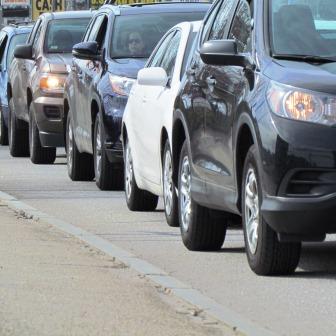When self-driving cars or autonomous cars are accepted everywhere, will the government ever ban human driven cars?

Let’s look at what’s behind the push for self-driving cars, also called “autonomous cars”.
We all know computer people want to take over the world.
In stores, self-checkouts now slowly overtake the function of the check-out person.
We see in in our smart phones where computer driven “robocalls” constantly annoy us.
Call your insurance company, electric utility or anyone in government and try getting an actual human being and not a computer driven voice tree leading in circles.
Slowly, one byte at a time, computer technology crept into our cars and trucks.
Self-Driving Cars, One Step at a Time
Computer chips appeared first in cars in the diagnostic systems. Slowly, various auto-drive features appeared. At this writing the world stands on the edge of artificial intelligence fully taking over the driving function in autonomous cars, also sometimes called driverless cars. More accurately, they’re cars driven by computers.
Insurance companies seem in love with autonomous vehicles. Why? Study after study reveals car accidents caused by human error. People don’t pay attention to their driving, causing wholly avoidable rear end accidents. Distracted driving, drunk driving and other indisputable human faults cause serious motor vehicle accidents every day.
Human error causes 94 per cent of all car accidents. That statistic comes from NHTSA, the National Highway Traffic Safety Administration, which studies accidents and traffic data.
Armed with that and other accident studies revealing how bad human behavior causes tragedy on the roads, insurance companies love the autonomous vehicle idea. They figure if they can replace human drivers with computers, accidents will decline. They conjure up statistical data claiming you’re almost certainly safer in a computer-driven car than one driven by a human.
Automakers, too embrace the autonomous driver idea, spending billions on self-driving technology.
Self-Driving Cars: Not so Fast
The headline in a tech website itself almost tells the story of present progress:
“6 Self-Driving Car Crashes That Tapped the Brakes on the Autonomous Revolution.”
Digital Trends, June 22, 2018.
Techie authors of the article foresee that computer driven cars will not bring the end of car accidents. Human error and technical faults both cause motor vehicle accidents.
A self-driving Lexus caused the first crash of an autonomous vehicle when it rear ended another car in Mountain View, CA. The July 2015 accident caused minor injuries to three passengers and the driver of the car that it hit.
Then in January 2016 the first apparent fatality in a crash involving a semi-autonomous car killed the driver. Tesla’s advanced driver assistance system or ADAS offers semi-autonomous driver assistance but requires driver attention. Just three months after the feature was introduced to Chinese drivers, the Tesla Model S sedan crashed into the back of another vehicle in perfectly clear weather after making no attempt to brake, killing the driver.
A fully self-driving Lexus in February 2016 attempted to merge into traffic. Instead it struck the side of a bus. Designers admitted fault and promised a redesign of the software.
The first U.S. death caused by autonomous driving technology came in May, 2016. Car sensors in highway driving conditions failed to see an 18-wheeler crossing the highway and drove full speed under the big rig’s trailer. The fatal car crash drew an admission from Tesla that autopilot “is not perfect”.
Rush to the Highway
Viewing all of the above as learning curve issues vehicle designers and insurance companies drive on in their goal of replacing human drivers with computers. Tesla promises its self-driving “robotaxi” service will hit the roads in the near future. Elon Musk’s promise at an event titled “Autonomy Investor Day” featured descriptions of taxi cabs without a driver.
If a taxi showed up at your door without a driver, would you get in?
Lots of people continue to have questions.
“One thing is certain: Driverless vehicles will not be as safe as the auto and tech industries claim. What we do know is that automakers have shown that they continue to be driven by profit instead of safety.”
Elise R. Sanguinetti, President, American Association for Justice, Trial, February 2019.
State lawmakers continue to scratch their heads over new laws to stay ahead of cars without human drivers. When there’s an accident, who’s responsible? Manufacturers and software people pass the buck and do you hold the owner of the vehicle at fault? These questions now percolate through the legal system without full resolution.
5 Auto Driving Features
While putting computers in charge, completely eliminating a human driver may not be the best idea. Some computer features provide assistance to the human driver. Here are 5 auto driving features that might help a human driver and reduce the likelihood of totally computerized cars:
Automatic Emergency Braking applies the brakes to prevent a collision when it senses a vehicle in the way. The feature can also reduce the force of impact when the crash can’t be avoided.
Forward Collision Warning gives drivers an audible or visual alert when a crash may be imminent.
Blind Spot Warning notifies the driver when a vehicle is in the blind spot.
Lane Assist Technology warns the driver if the vehicle strays out of the lane. Some systems, if there’s no response, take steps to steer the vehicle back into line. Other systems keep the car in the center of the lane.
Pedestrian Detection does what is says and alerts the driver of people or bicycles potentially in the way and can trigger automatic emergency braking.
These and other features are here now. Although initial versions in some cases caused problems, the auto techies continue to fine tune these and other ideas.
Fully Automated Cars: Really?
Who hasn’t sat in front of a computer while it crashed, waiting for it to come back or wondering whether to call “the guy”. Who hasn’t had a computer or “smart” phone force an upgrade to an operating system only to find the new system now brings a chain reaction of other problems?
Automated flight software is highly suspected in two fatal crashes of Boeing 737 Max airliners. 189 people died on October 29, 2018 when a Lion Air jet taking off from Jakarta, Indonesia immediately started going nose down. Pilots frantically attempted to push the plane’s nose up until it crashed 13 minutes later. An eerily similar 737 Max 8 crash less than 5 months later, on March 10, 2019 killed 157 when the plane nose-dived and crashed 6 minutes after taking off from Addis Ababa, Ethiopia.
Unbelievably, in the moments before the crash of the Indonesian jet, pilots grabbed a manual:
“The pilots of the doomed Lion Air flight that crashed into the Java Sea last October frantically searched the aircraft’s manual to try to find a way to keep the plane under control before the crash, cockpit voice recordings show.”
Business Insider, March 20, 2019
Drivers often face only seconds, if that, to take evasive action to avoid a car accident. Time to dig into the glove box to find, much less read through, a manual on the auto drive system?
Answer to the Question on Banning Human Driven Cars
Based on current technology and into the foreseeable future, I can’t see government actually banning human-driven cars. Computer features in aircraft haven’t always worked out so well. As pointed out above, computers are not perfect and are prone to crash, freeze, and downright fail those relying on them.
What about all of the jobs lost should self-driving cars become law? Lawmakers would think twice before eliminating jobs ranging from the pizza delivery person to the truck driver who brings all of the stuff ordered on-line. Also remember that all of the stock in the so-called “brick and mortar” stores gets there, presently, in vehicles driven by humans. Not to mention the thousands employed moving and delivering the mail by way of the postal service.
No, I don’t see human driven cars outlawed. Not in the foreseeable future.
Written by Attorney Andrew D. Myers, a personal injury attorney in North Andover, Massachusetts and Derry, New Hampshire. If you have sustained injury in a car accident or other life altering event through no fault of your own, contact our office for a free initial consultation.
Other blog articles include highway hazards such as distracted driving, the cause of many serious car accidents that is not getting any better with time or publicity.
Sources:
Critical Reasons for Crashes Investigated in the National Motor Vehicle Crash Causation Survey, NHTSA, Traffic Safety Facts, February 2015.
6 Self-Driving Car Crashes that Tapped the Brakes on the Autonomous Revolution, Digital Trends, Lulu Chang & Luke Dormehl, June 22, 2018.
Visits: 239




